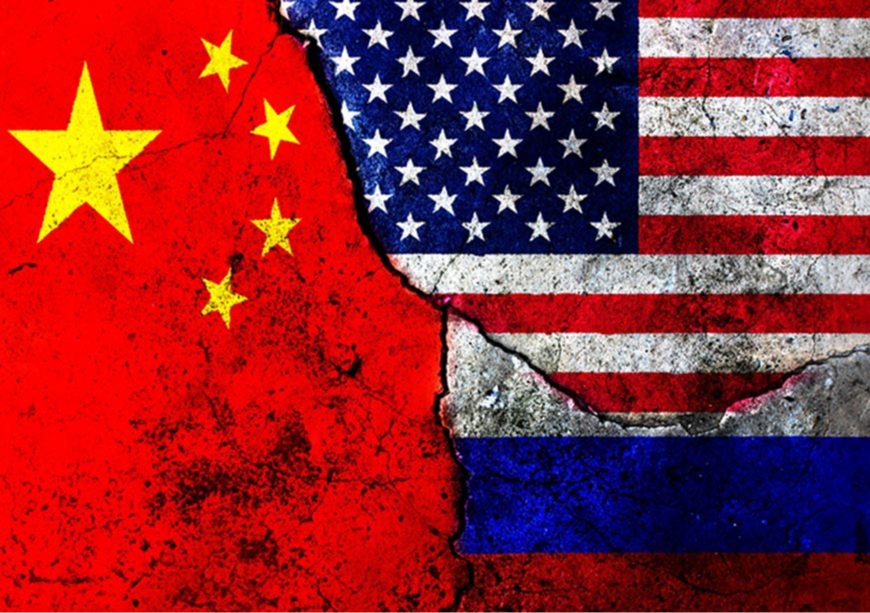
Source Image: Substack
This article is part of the series—Raisina Edit 2024
In the contemporary geopolitical landscape, debates are intensifying over the nature and trajectory of the global order. Some analogise the current situation to the precariousness of 1914, suggesting that the world is on the brink of a third World War. Others liken it to 1945, anticipating a new Cold War, primarily between the United States (US) and China. However, current tensions could be placed within the framework of Cold War 2.0, emblematic of a deepening rift between the US, on the one hand, and the DragonBear modus vivendi (China and Russia), on the other, amidst the bifurcation of the global system and the Fourth Industrial Revolution (4IR). Against this backdrop, Russia's military actions in Ukraine and the military conflict between Israel and Hamas are not isolated events but a manifestation of this Cold War 2.0. They reflect a broader geopolitical realignment, a division of the world that seems to deepen with each passing year. The year 2024 is poised to witness a new escalation in the Indo-Pacific region, where North Korea’s actions and simmering tensions in the South China Sea and the Taiwan Strait, fuelled by China and Russia, will converge with the ongoing conflicts in Eastern Europe and the Middle East.
Against this backdrop, Russia's military actions in Ukraine and the military conflict between Israel and Hamas are not isolated events but a manifestation of this Cold War 2.0.
In the intricate embroidery of current global politics, the prospect of a direct military clash involving the US, China, and Russia is relatively low. This restraint stems not from a lack of capability or manifold conflictual interests but rather from a mutual understanding of the catastrophic consequences such a global conflict would entail. Instead, these major powers demonstrate a preference for strategic manoeuvring, engaging in a complex dance of diplomacy, geoeconomic pressures, and regional influence as we are currently observing in the crisis in the Red Sea, where the Iran-backed Houthi promised safe passage for Chinese and Russian ships. This approach allows them to advance their interests and assert their influence without crossing the threshold into open kinetic warfare. The strategic posturing, often playing out in proxy conflicts or through technological and geoeconomic competition over the access and control of critical resources and infrastructure, underscores a new era of geopolitical rivalry. It reflects a nuanced understanding that, in a world interconnected by global markets, digital industrial revolution, and shared ecological challenges, the costs of traditional warfare far outweigh the potential gains.
Nuclear weapons
In the shadow of the looming Cold War 2.0, the spectre of nuclear weapons deployment, while present, remains an improbable outcome. The rationale behind this restraint is rooted in the mutual recognition of the devastating consequences of such actions, governed by the doctrine of mutually-assured destruction. However, this does not equate to nuclear complacency. On the contrary, the current geopolitical climate is likely to fuel an intensification in nuclear arms development and armament, signalling a resurgence of an arms race reminiscent of the mid-20th century but on a much bigger scale and scope. This trend will be marked by advanced technological innovations in nuclear weaponry, increased stockpiling, and the modernisation of arsenals. We might observe an emergence of new nations, like Iran, approaching the threshold of nuclear weapon acquisition. This escalation reflects a strategic posturing by major powers to bolster their deterrence capabilities and maintain a balance of power. Nevertheless, it also raises the stakes in global security, as the proliferation of nuclear weapons increases the risk of miscalculations and accidental engagements, thus adding a complex layer of tension to international relations.
The rationale behind this restraint is rooted in the mutual recognition of the devastating consequences of such actions, governed by the doctrine of mutually-assured destruction.
Bifurcation of the global system
The contemporary global geoeconomic landscape is witnessing a continuous bifurcation, with trade, technology, and financial systems increasingly polarising along geopolitical lines. This trend, reflective of the broader tensions characterising the Cold War 2.0, is set to extend deeply into the realms of global finance this year. In response to this fragmented and fractured global order, notable shifts are anticipated from major economic blocs like the G20 and BRICS in 2024. These countries with the most vibrant economies are expected to actively explore and possibly implement alternatives to the US Dollar, which has long dominated international trade and finance. Such moves will signify a substantial reconfiguration of the global financial architecture, driven by the desire to mitigate dependency on a singular dominant currency and to foster a more multipolar financial world. This strategic diversification aims not only to reflect the changing geoeconomic realities and shifting global supplies but also to provide a buffer against geopolitical uncertainties and the economic dominance of any single nation.
Moreover, the current geopolitical climate is markedly contributing to the irreversible disruption of global supply chains, a phenomenon that is reshaping international trade and economic dynamics. In this context of Cold War 2.0, a notable escalation in the competition for control over strategic global chokepoints is emerging. Vital maritime routes such as the Black Sea and the Bab-el-Mandeb Strait in the Red Sea are becoming arenas of intensified geopolitical contestation, as nations vie for influence over these critical junctures in global shipping. Concurrently, the North Sea Route will be gaining increased prominence as a pivotal link between Russia and China, offering a strategic alternative to traditional shipping lanes. This development is paralleled by the growing significance of land-based trade corridors. Initiatives like China's Belt and Road Initiative (BRI), the International North-South Transport Corridor (INSTC), and the recently proposed India-Middle East-Europe Corridor (IMEC) are increasingly central in facilitating cross-continental trade. These multimodal connectivity routes not only diversify the means of global trade but also reflect shifting alliances and economic priorities in a world where traditional supply chain models are being redefined by geopolitical realities. The outcome of these developments is a more fragmented and competitive landscape for global trade, with far-reaching implications for international relations.
Vital maritime routes such as the Black Sea and the Bab-el-Mandeb Strait in the Red Sea are becoming arenas of intensified geopolitical contestation, as nations vie for influence over these critical junctures in global shipping.
China’s “death by thousand cuts” approach
China's stance towards Taiwan, a crucial and sensitive issue in contemporary geopolitics, is characterised more by a strategy of attrition rather than the urgency of a full-scale military invasion. While the possibility of such an attack cannot be entirely discounted, it is not deemed the most probable scenario given the complex international repercussions it would entail. Instead, China seems to be employing a multifaceted approach that tactically combines enhanced military pressure with political infiltration and socio-economic coercion.
This methodical strategy aims to gradually undermine Taiwan's resistance and assert Beijing's influence over the island. Military manoeuvres in the Taiwan Strait and the South China Sea serve as demonstrations of power and intent, while political tactics are designed to sway public opinion and erode internal support for independence following Taiwan’s election of DPP former vice-president Lai Ching-te. Economic measures, such as trade restrictions, are used to exert financial pressure. This nuanced approach reflects China's long-term ‘death by thousand cuts’ strategic approach to Taiwan, balancing its desire for unification with the need to manage the risks of direct conflict and international condemnation.
The Israel-Palestinian two-state solution on the horizon
The Israel-Hamas conflict, a longstanding geopolitical issue, shows strong signs of persisting into 2024. While the possibility of this escalating into a larger regional war is currently assessed as low, the situation remains volatile, with potential de-escalation anticipated in the coming spring or summer. The enduring hope for a two-state solution to the Israeli-Palestinian conflict continues to be a subject of international discourse, although achieving this remains complex and fraught with significant humanitarian concerns. Complicating the regional dynamics are the spillover effects from other conflicts in the Middle East. Notably, the Iran-backed Houthi's attacks on commercial shipping in the Bab-el-Mandeb Strait have significant implications for global trade, prompting the rerouting of commodities shipping around the Cape of Good Hope in South Africa, a key BRICS partner. These incidents reflect the broader tensions in the Middle East, illustrating the complex web of cascading geopolitical effects that continue to challenge peace and security in the region and beyond.
The enduring hope for a two-state solution to the Israeli-Palestinian conflict continues to be a subject of international discourse, although achieving this remains complex and fraught with significant humanitarian concerns.
Russia’s war of attrition and a new Iron Curtain in Europe
As we look ahead to 2024, the ongoing war between Russia and Ukraine shows no immediate signs of resolution, with the likelihood of its continuation into the foreseeable future. However, there appears to be a glimmer of hope for diplomacy, as potential talks are speculated to emerge this autumn. These discussions, if they materialise, could mark a critical juncture in this prolonged war. In the interim, Russia is poised to face significant internal political challenges amid a presidential election campaign in spring, potentially leading to substantial political reshuffling in the upcoming years.
Moreover, the prospect of Ukraine's territorial partition remains a concerning possibility. This risk is heightened by the absence of a unified strategic consensus among Western nations, particularly regarding the desired outcome of Ukraine's victory and the re-establishment of its borders as recognised internationally in 1991. This slow delivery of military aid and the lack of strategic vision on behalf of the European Union (EU) states not only complicates the diplomatic landscape but also adds to the uncertainty surrounding the future territorial integrity of Ukraine.
As the world grapples with the escalating tensions of Cold War 2.0, a new Iron Curtain appears poised to emerge, this time along NATO's Eastern Flank and Russia’s West Flank. This geopolitical divide is expected to stretch from the icy expanses of the Arctic to the strategic waters of the Baltic, Black Sea, and the Eastern Mediterranean, encapsulating a vast region that includes Scandinavia, the Baltic states, Central and Eastern Europe, and Türkiye, and once again create a bifurcated Europe similar to the first Cold War. This significant development in the global security architecture coincides with a momentous occasion—the 75th anniversary of NATO, which will be commemorated with celebrations in Washington. This symbolic convergence of events underscores the shifting geopolitical landscape and the renewed significance of NATO in countering emerging threats and bolstering security along its northern and eastern boundaries. The formation of this new barrier is more than a mere physical demarcation; it represents a deepening ideological and strategic rift between the alliance and its adversaries, marking a profound transformation in the geopolitical order of the 21st century.
Russia is poised to face significant internal political challenges amid a presidential election campaign in spring, potentially leading to substantial political reshuffling in the upcoming years.
India’s role
The upcoming years are set to witness a pivotal shift in global dynamics, prominently marked by India's inevitable rise in both geopolitical and geoeconomic spheres. India, with its burgeoning economy and demographics, strategic location, and growing influence, is poised to play a more significant role on the world stage. This ascendancy is not just emblematic of India's own growth, but it also reflects a broader trend: The increasing importance of the Global South in shaping international affairs. This shift will be particularly visible in high-profile international forums such as the G20, set to be hosted by Brazil, and the BRICS Summit in Russia. These platforms will provide opportunities for countries in the Global South, led by India, to exert greater influence on global economic policies, development agendas, and geopolitical strategies. As these nations assert their voices and interests more forcefully, the traditional balance of power and decision-making in international politics is likely to see a significant realignment, marking a new era in global governance.
Elections supercycle in 2024
Last but not least, the year 2024 is poised to be a landmark period in global politics, marked by what is being termed as an ‘election supercycle.’ This phase is distinguished by a significant number of electoral events around the world, and more notably, by a pronounced surge in populism across the political spectrum, from the left to the right. This rise in populism reflects a growing disillusionment with traditional political establishments and a shift towards more extreme, often nationalist, ideologies. The outcomes of these elections are likely to reshape policies and alliances, as political leaders will also pursue more protectionist and isolationist agendas. This trend could lead to increased unpredictability in international diplomacy, shifts in global trade and security policies, and potentially, a reconfiguration of long-standing alliances. The 2024 ‘election supercycle’, thus, is a critical juncture, one that could redefine the contours of global politics in the years to come.
The Cold War 2.0 paradigm aptly captures the essence of current international relations, characterised by strategic competition, regional conflicts, geoeconomic and technological bifurcation, and the looming spectre of military escalation.
Conclusion
In conclusion, as the world navigates through this complex and evolving geopolitical landscape, the interplay between the US and the DragonBear alliance will underpin much of the global and regional tensions and realignment. The Cold War 2.0 paradigm aptly captures the essence of current international relations, characterised by strategic competition, regional conflicts, geoeconomic and technological bifurcation, and the looming spectre of military escalation. The resolution of these tensions, or the lack thereof, will undoubtedly shape the geopolitical contours of the 21st century.
Velina Tchakarova is Founder of FACE and Visiting Fellow at the Observer Research Foundation.
The views expressed above belong to the author(s). ORF research and analyses now available on Telegram! Click here to access our curated content — blogs, longforms and interviews.




 PREV
PREV



